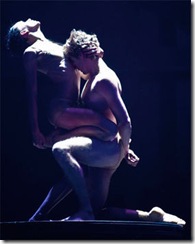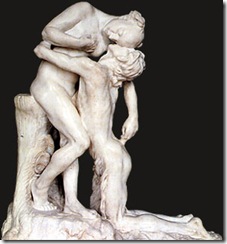Rodin/Claudel : Valérie Legat from Les Grands Ballets Canadiens shines as Camille Claudel, the fragile, vulnerable genious driven to despair.
The passionate and troubled love story between Auguste Rodin and Camille Claudel has a become a near legendary tale that has attracted artists, feminists, art historians, theatre specialists, psychiatrists and all manner of people interested in the functioning of the artistic genius.  (Photos: André Tremblay)
(Photos: André Tremblay)
Les Grands Ballets Canadiens de Montréal has brought in choreographer Peter Quanz’s version of this relationship which highlights Camille Claudel’s links to her family, her famous brother who was about to become a poet, diplomat and playwright (l’Annonce faite à Marie, le Soulier de Satin, Partage de midi et many more), her ongoing affair with the sculptor, the jealousy of Rodin’s wife, Camille’s plunge into the depths of depression, the fact that she destroyed most of her sculpture and the fact that her devoutly Catholic family, conscious of its good place in society, refused to support her. They would not recognize her genius and kept her interned for over 30 years. Brother Paul Claudel apparently did not make any attempt to help her either, something which strengthens my dislike of his theatre even more.
This performance was essentially a narrative ballet based on the balletic training of the company and the precision of the dancing was something wonderful to watch. However, choreographer Peter Quanz was faced with a stylistic dilemma because he had to use dance to represent the work of two artists who communicate through an art form which does not involve the moving body, but rather the three dimensional representation of bodies that are moulded out of clay or stone, or plaster and that are made to come alive. At the same time there is the lyrical and highly emotional representation of this relationship that shows the personal the attraction between the two artists, Rodin’s love of his work, and his attraction to the models he uses for his work. There is also Paul’s need to be included into the right Parisian society to further his career, Rodin’s troubled relationship with his wife and Camille’s violent jealousy that possesses her and sends her into madness.
The solution was a performance that, although a bit cluttered with information, for the most part, glowed with beauty and originality. Among other things, it tried to emphasize the evolution of this relationship through their creative gestures as sculptors. The passionate first encounter between Rodin (Marcin Kaczorowski 27th ) and Camille ( Valentine Legat 27th) while the master is planning the Gates of Hell with his disciples ( we see a half finished structure that is supposed to represent the work of art), is set to the music of Debussy, L’Après- midi d’un faune. It turns into a most stunning illustration of the way the couple fall in love by discovering each other and their respective artistic talents as they caress the sculptural forms of the dancers. During this sequence, the choreographer gives Rodin movements that send us back to Nijinski’s shocking performance where he is inspired by Nijinki’s choreographpy, taken from the dancers on the flattened surfaces of Grecian urns as the satyr tries to seduce the young woman. The choreography also uses the bodies of living sculpted figures as primal material transformed by the sculptor himself. He intertwines himself with the flesh- coloured sculpted bodies that appear to come alive as they are handled by the artists, moulding them into works of art. These bodies take on the poses of Rodin’s famous works, as they are transformed by Claudel’s and Rodin’s touch, creating a whole landscape of sculpture around them. Unfortunately, even though Kaczorowski’s style is technically impeccable, he lacks any kind of sensuality, or passion that nurture this delicious pas de deux where Valentine Legat shines like a weightless, fragile and most vulnerable creature. Because of Rodin’s apparent lack of emotion, the fire between the couple did not burn and that was such a shame.
In Act II, the music adds much to the process as the interaction between the Rodin, Camille and the living sculpture play out the troubled relationship between the two artists. During an exhibition of Camille’s work we see the bourgeois public , loyal to Rodin, moving in a more conservative and synchronized from of dance while the sculpted forms from Camille’s exhibition come alive and create a tableau of joyous chaos, suggesting her more avant-garde talent, the highly original style of her work and the fact that she has no doubt surpassed the master, something he could never have accepted. That scene prepared us for everything that was to come. Emphasizing the emotional turmoil of Camille’s brother was not particularly useful in this narrative whereas the artistic conflict, as well as the emotional conflict between the couple, might have been emphasized even more.
The music, chosen from the period always suggested the creative turmoil of the period and the great precision of the dancing was very pleasing indeed but there is no ignoring the fact that Kaczorowski’s expression of seductive desire did not match his physical prowess and the spark between the lovers seemed very one sided to say the least. One feels this piece might continue evolving even more..it would certainly be worth the effort.
Rodin/Claudel
Les Grands Ballets Canadiens de Montréal. March 27-29, 2014
